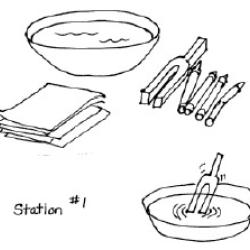Source Institutions
Source Institutions
Add to list Go to activity
Activity link broken? See if it's at the internet archive

This lesson (on pages 15-24 of PDF) explores how sound is caused by vibrating objects. It explains that we hear by feeling vibrations passing through the air. Learners take part in several demonstrations, making those vibrations visible. They put a tuning fork in a shallow pan of water and use it to bounce a ping-pong ball, showing the fact that the tuning fork is vibrating when it's making a sound. There are extensions described involving comb kazoos, rubber band guitars, and putting rice or cereal on top of a drum.
- 30 to 45 minutes
- 10 to 30 minutes
- $1 - $5 per group of students
- Ages 4 - 18
- Activity, Demonstration, Lesson/Lesson Plan
- English
Quick Guide
Materials List (per group of students)
- Tuning fork
- Pan or unbreakable bowl, approx. (1–2 quart)
- Water (2–3 cups)
- Paper
- Crayons
- Ping-Pong ball
- String (about 18 inches)
- Tape
- Optional: Drum(s) (any drum or tambourine will work)
- Optional: 2–5 small unbreakable containers (e.g., a plastic cup or 8 oz. clean, empty yogurt container)
- Optional: Spoon (plastic or metal, coffee spoon size is fine)
- Optional: Rice grains
- Optional: Cornflake-type cereal flakes;
- Optional: other small dry ingredients similar to rice and cornflakes
- Optional: Wastebasket
- Optional: Empty tissue box (flat rectangular variety)
- Optional: Rubber bands of various sizes
- Optional: Waxed paper
- Optional: New, small plastic combs (1 per pupil) (small combs work well)
Subjects
-
Life Sciences
-
Human Senses and Perception
- Hearing
-
Human Senses and Perception
-
Physical Sciences
-
Vibration and Waves
- Sound
-
Vibration and Waves
Informal Categories
- Music
Audience
To use this activity, learners need to:
- see
- hear
- touch
Learning styles supported:
- Involves hands-on or lab activities
Other
This resource is part of:
Access Rights:
- Free access
By:
Rights:
- All rights reserved, OMSI, 2010
Funding Source:
- National Institutes of Health, National Center for Research Resources, "Science Education Partnerships Award", R25 RR15634
